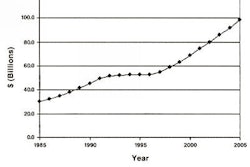

Granted it will take an initial investment of time, but there is evidence to support the wisdom of defining one or two process improvement goals every year. Even small, proactive steps begin to chip away at the series of fires (or sometimes head off issues otherwise threatening to burst into flames).
The book Juran Institute's Six Sigma: Breakthrough and Beyond (McGraw-Hill Companies, New York City, 2004) describes the concept of poorly performing processes (COP3) and notes: "A recent report provided by the Midwest Business Group on Health, and the Juran Institute, showed that the total costs of poor quality in the United States healthcare system is approaching 30% of the $1.3 trillion spent annually on healthcare."
Further, the authors wrote: "... the costs of poor quality (COPQ) are the costs of unplanned, unnecessary waste.... Historically, studies have shown costs of poor quality to run as high as 15% to 40% of costs of goods sold or about 15% to 20% of sales revenue, an extraordinary sum of money lost."
COP3 in radiology
As any hospital-based radiology practice can attest, much of the billing department's efforts revolve around responding to errors beginning with missing and incorrect information in demographic downloads. Or handling the series of statements sent to uninsured patients, only to find out that they "gave that information at the hospital" and did not respond to the group's bills as a result -- until the collection agency letter arrived. Or managing rebilling and repeated appeals because the information was "almost" right the first time.
Each instance of repeated effort means wasted time and increased overhead. In many cases, deficiencies of a legacy practice management system result in hiring more staff to compensate, not to mention the fact employees can develop complex procedures in their self-developed workarounds. While radiology has not yet established industry-wide internal process deficiency costs, there are in fact several applicable examples:
- Working overtime to make up for backlogs or imaging center scheduling issues
- Increased manual processes due to technology limitations
- Repeat films
- Rescheduling and maintenance costs for unplanned equipment downtime
- Correcting errors in various databases
- Timely filing denials
- Investigating and resolving complaints
- Bad debt write-offs
- Correcting billing errors
- Adjustments by payor for noncontractual allowances (denied claims)
- Legal costs associated with employee disciplinary actions
Poorly performing processes contribute to bad debt write-offs, excessive adjustments, and increased staffing levels. If these areas can be significantly impacted by improvements in internal processes and information technology, they represent a good starting point for a process improvement initiative.
Selecting the process improvement project
One of the benefits of the business of radiology is that it is all about process -- from the scheduling of an imaging center patient through the steps involved in setting up a patient payment plan. The individual steps are identifiable, and in most cases processes can be modified for greater efficiency.
If you could work on one project that would have the greatest impact on the business, what would it be? Keep in mind the project does not necessarily have to result in a direct financial impact. For example, most practices experiencing rapid growth reach a crisis in terms of handling human resource tasks -- and eventually processes that previously worked suddenly begin to fail. The result? The group faces an increased risk of legal action -- or finds the practice unable to terminate a problem employee as documentation falls short.
Still short of ideas (or unable to prioritize)? Talk to the people who do the work. Ask about their frustrations -- or the one "fix" that would make their jobs easier. Ask if there are tasks they do every day that seem really stupid. The latter question usually uncovers duplicate processes, which served a purpose at one time but have since become outdated. These persistent processes manage to live on because "that's the way we've always done it" and nobody has systematically examined them.
Rather than approach the process review task one person at a time, pull in the staff by department. Talk to the payment posters, people sending out paper claims, those who handle insurance correspondence or claims follow-up, and staff members involved in private pay collections. Inevitably some problems can be solved on the spot, often to the amazement of the manager who did not know they existed. Others will be more complicated -- and offer process improvement opportunities.
From this series of interviews, identifying one or two projects offering the potential for noticeable impact should be possible. A side benefit is improved morale as employees have the opportunity to talk about their concerns and offer suggestions for improvement.
So who does the work?
Process improvement is a task best solved by cross-functional representation. The manager who attempts to solve problems alone in the office will usually miss the mark. Healthcare is a business of exceptions and is not held back by logic. That means a healthy dialogue involves proposing a solution, then dealing with the "Yes, but how does that work when this happens?"
Cross-functional teams help provide more well-rounded results. For example, it is not unusual for a perfectly logical "fix" in one area to potentially raise havoc in another, so it helps to have each department buy off on proposed process changes.
Departmental representation also reduces the finger pointing, as employees learn more about the overall workflow. For example, an insurance follow-up department lamented, "If the charge posters just cared about the quality of their work, our lives would be much easier."
During an explanation of how the charge posters received their information (from the hospital), it was evident they had little control over the quality of the data at all. Instead, the groups began to work together to share information about problems they were encountering. As a result, when a particular insurance company's information came over on the hospital download and was denied as incorrect, the insurance staff notified the charge posters so they could look for this payor and manually override the downloaded information. While several problems were fixed by the team, they also commented on the improved working atmosphere as each gained an appreciation of the other's challenges.
More on the improvement process
Define the problem. For example, "Referring physicians are dissatisfied with the imaging center's scheduling process." What are the benefits of solving this problem? Improved physician satisfaction, more efficient scheduling, better prepared patients, less frenzied front desk staff, fewer errors, and improved billing?
Map the process. Outline the current steps involved in the scheduling process.
What are the variables? Where do problems occur, and what is the potential for the process to fail? For example, scheduling backlogs escalate late in the morning when patient traffic is also the heaviest.
Design the improved process. What does the scheduling staff need to improve the quality of their work? For example, a busy imaging center finds dedicated schedulers are needed, with other employees assigned to greet and register the patients.
Test the new process. Not everything works in real life as well as it does on paper. However, closely monitoring and modifying the new process after implementation will help ensure success.
Identifying one or two projects each year moves the organization one step closer to proactive management. Healthcare will probably never be a stable industry since, if nothing else, we face seemingly annual fee reductions, the introduction of new modalities, and payors changing the rules. Gaining control over those aspects that can be controlled represents a logical first step to an improved business. In addition, involving employees reduces their aversion to change, and improves the likelihood of the new process working smoothly.
By Patricia A. Kroken
AuntMinnie.com contributing writer
July 27, 2006
This article originally appeared in the Radiology Business Management Association's "RBMA Bulletin" and is provided for AuntMinnie.com members through the permission of the RBMA. For further information about the association, the RBMA may be contacted at 888-224-7262 or via its Web site.
Patricia Kroken is a principal in Healthcare Resource Providers, an Albuquerque, NM-based radiology business consulting firm. She is a past president of the RBMA, a fellow in the American College of Medical Practice Executives, and a certified radiology administrator. Kroken may be contacted at 505-856-6128 or via her firm's Web site.
Related Reading
Strategic planning considerations and the Deficit Reduction Act of 2005, June 27, 2006
Work-site assessments reduce risk exposure and improve productivity, May 17, 2006
Unlock success with strategy, research, April 27, 2006
Referral physician relationships drive imaging center success, November 25, 2005
Successful customer service requires scrutiny, October 17, 2005
Copyright © 2006 RBMA



















